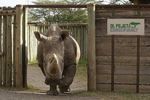GEO MATTERS - UN Environment
←
→
Page content transcription
If your browser does not render page correctly, please read the page content below
GEO MATTERS
Developing a Technical Summary of the Sixth Global Environment Outlook
FEBRUARY 2018
By Joyeeta Gupta and Paul Ekins (Co-Chairs of the sixth edition of the Global Environment Outlook)
The sixth Global Environment Outlook has been in development since early 2017 and will be published by March
2019. This global assessment focuses more on proposing solutions to our environmental challenges rather than the
environmental impacts themselves. As the co-chairs of the process, we want to ensure that this assessment has the
most significant impact possible and we have made some important suggestions to try to make this happen. These
include:
• The Global Environment Outlook report will be divided equally across the subject areas of
- reporting on the state of the environment,
- assessing our policy response and its effectiveness, and finally,
- examining possible environmental futures and the main pathways to achieving them.
• We intend the report to have a Technical Summary of about 50 pages, which provides the main findings of the
assessment in a concise and easy to use format. This should allow policy analysts and researchers to use these
findings more efficiently in the analysis that they conduct for environmental decision makers.
• We would like the Global Environment Outlook to be published by a scientific press and publisher. We feel
this will increase the reach of the report within the scientific research and education community, allowing the
document to have a more significant impact.
Of course, each of these innovations to the Global Environment Outlook process and the report itself will require
outstanding work by the author teams, the main advisory bodies to the assessment and the UN Environment
Secretariat. However, we believe these changes will increase the prestige of the publication, its reach across different
user communities and will help the Global Environment Outlook complement the other global assessments that
will also be published around the same time. It is important to us that all the hard work that goes into producing
this assessment reaches the highest number of people and helps lead to real change.
We hope that these changes will help you, as readers and users, access and understand these findings more easily
and apply them to your daily work and your daily lives in a concrete way. We will continue to try to find new ways
to present the information in the assessment in innovative ways that reach out and grab your attention. It is the only
way that the Global Environment Outlook can help move forward the environmental transformation that we need.
-1-Science-Policy-Business Forum
The first UN Science-Policy-Business Forum took place on
the 2nd and 3rd of December 2017 right before the third
edition of the United Nations Environment Assembly. The
high expectations around this crucial event for the future of
our environment have been satisfied with the engagement
of more than 700 participants, including 300 Scientists and
Academics, 168 Top Business Personalities and CEOs, 130
Civil Society Representatives and several Government
representatives. The forum aimed to strengthen the
broader interface between science, policy, business and
society by building consensus around critical issues and by
tearing down traditional barriers between these sectors. In
line with the theme chosen for the United Nations Environment Assembly, the forum focused on shedding lights
on green solutions to address the global pollution threat and to identify and promote opportunities to grow green
technology markets, driven by advances in science and technology, empowering policies and innovative financing. A
series of side events tackling water and air pollution, circular economy, food security and new technologies around
the energy sector have been successfully organized.
Some of the key findings of the forum concern:
- the key role of big data, which requests a significant investment in science and capacity building in the majority
of the world to bridge the gap that inequality has left us with;
- the enormous potential of the business communities, which hold the key to green solutions with innovative
technical know-how and the ability to scale up through green investment and green supply chains;
In support of the Science-Policy-
Business forum, a Steering committee
has also been created that is supposed
to shape the environmental agenda
and inform the Member States during
the United Nations Environmental
Assemblies.
UN Environment will continue facilita-
ting the Forum and make efforts to
make it the most influential annual
event advocating for a radical new
approach to the Environment.
Know an Expert: Global Environment Outlook Fellow Profile
Carol Zastavniouk from Canada is one of the Fellows of the sixth edition of the
Global Environment Outlook, contributing mainly to the Biodiversity thematic and
policy chapters. She completed her combined Arts and Science Bachelor’s degree
in Environment at McGill University with a focus on ecology and an M.Sc. Biology
at Concordia University in Montreal, studying the effects of habitat fragmentation
on brook trout in Newfoundland. Her introduction to ecological research started
by working in primatology conservation and mammalogy/parasitology laboratories.
Carol has recently started working as an aquatics biologist at the environmental
consulting firm Golder Associates in Calgary, learning about the interplays between
Canada’s energy industry and its government’s environmental policies, and applying
ecological assessment and monitoring techniques to protect Canadian wildlife.
She is also passionate about the maintenance and creation of green space and
wildlife corridors alongside human spaces. Carol is excited to learn from the Global
Environment Outlook process and work alongside world-renowned environment experts. She hopes the final
document will help world leaders to shape a better future for the earth.Protecting wildlife: Successful conservation stories from around the world
o by Simone Targettiferri
Imagine being a mother or father and being asked by your kids about tigers, lions, pandas and rhinos….. and imagine
finding the words to tell them that these animals do not exist anymore in forests and grasslands around the world.
e
How would you feel?
As a human being and young professional at UN Environment, I do not want to face this!
g
For this reason, and due to my deep admiration, interest and respect for our incredible wildlife, I decided a long time
ago to use the opportunity in my many travels to visit extraordinary conservation programmes around the world,
to meet the exemplary people behind them and to share these experiences with my network.
/
The International Union for Conservation of Nature Red List that assesses the conservation status of some existing
species is the most important platform to consult when it comes to endangered species. Biodiversity is declining
with more than 79,800 species registered in the International Union for Conservation of Nature Red List, and more
g
than 23,000 threatened with extinction, including 41% of amphibians, 34% of conifers, 33% of reef-building corals,
25% of mammals and 13% of birds (International Union for Conservation of Nature 2017). On the other side,
positive stories exist, such as the downlisting (i.e., improvement) of some species over the International Union for
Conservation of Nature Red List categories scale, due to conservation efforts.
r
The reclassification of central Africa’s Eastern
Gorilla as critically endangered follows a
o
population decline of more than 70% in the
last two decades due to habitat destruction
and poaching. From 1980, the governments of
Rwanda, Uganda, and the Democratic Republic
of Congo, in collaboration with the international
.
community, invested enormous resources for the
conservation of the Virunga mountain gorillas,
both using conventional conservation measures
p
such as ranger patrols and law enforcement,
and more extreme approaches of continuous
monitoring and in situ veterinary care. Due to
these efforts, the world population of mountain
e
gorillas is now estimated to be 880. Visiting the
Volcanoes National Park in 2015 and facing
the beauty of these free and joyful gorillas
represented a unique and magical experience.
n
The following year I had the chance to travel to Namibia and visit the Cheetah Conservation Fund in Otjiwarongo.
In this area, the main threat to these animals is represented by human-wildlife conflict. Over 90 percent of
cheetahs live outside protected management
areas, meaning that they live alongside human
communities. Most of these are commercial and
u
communal farming communities raising cows,
sheep, and goats. During the 1980s, livestock
and game farmers halved the Namibian
cheetah population, indiscriminately removing
.
nearly 10,000 cheetahs. That is why in 1990,
the Cheetah Conservation Fund was funded by
Dr. Laurie Marker who developed Human-
w
Wildlife mitigation programs, called Future
Farmers of Africa that, along with parallel
conservation projects is strengthening the
human-wildlife co-existence and helping the
race against the extinction. Meeting Dr. Marker,
w
learning about their educational and research
programme and spending one entire day
interacting with these animals showed me the
real value of human engagement in making a
w
difference in conservation.
-3-This year I have had the opportunity to travel to China and meet the Giant Pandas at the Chengdu Research
Base of Giant Panda Breeding. Although the International Union for Conservation of Nature warns that climate
change will threaten more than a third of the species’ bamboo habitat in the next 80 years, Giant Pandas moved
off the endangered list and the species is now listed as vulnerable thanks to years of targeted conservation efforts
that have preserved its forest habitat, giving them back their space and making food available to them. There are
no exact figures for the numbers of cubs, but estimates bring the total number of giant pandas to 2,060, of which
1,864 are adults.
Finally, a few months ago, I went to the Ol Pejeta Conservancy, Kenya, where I met Sudan a 44-year-old rhino
and one of the last Northern White Rhinoceros. The northern white rhinoceros is one of two subspecies of
existing white rhinoceros, together with the southern white rhino. Formerly, this rhinoceros was found in parts of
northwestern Uganda, southern Chad, southern South Sudan, the eastern part of the Central African Republic, and
northeast of the Democratic Republic of the Congo. His number one threat is the human being. One kilo of his
horn is worth up to $60,000 in some parts of the world where it is believed to have healing properties. Poachers
reduced the population from 500 to 8 between 1970 and 2010. Now, in 2017, the northern white rhinos are 3 in
the whole world. Since 2009, Sudan has been enclosed in a special compound, controlled 24 hours a day by armed
guardians with two other females of the same species, with scientists hoping for procreation. Despite the efforts,
no other northern white rhino was born. In 2011, the International Union for Conservation agreed to consider the
subspecies as “critically endangered (possibly extinct in freedom).” If it is confirmed, its extinction in the wild will be
declared, despite the efforts that the Ol Pejeta Conservancy has made for its reintroduction. Currently, there are
no longer any specimens in captivity.
These exciting experiences gave me the
hope that we can make the difference
in preserving our wildlife and natural
resources. To be part of
this change, I decided to
attend training on
Economic Tools for
Conservation at
the University of
California,
Berkeley last
summer. We have
an opportunity and an
obligation to act, for this
generation and the future
ones; we cannot miss it.
-4-You can also read


























































